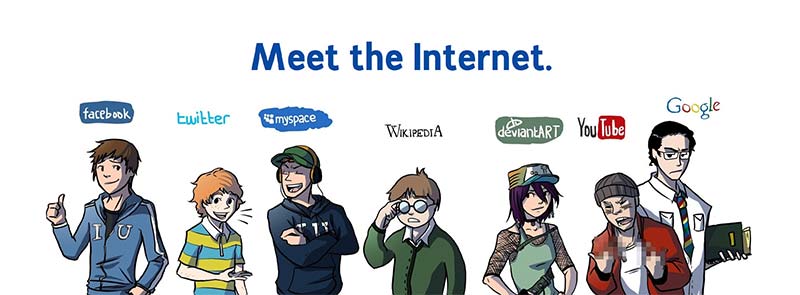
History of the Internet by Ethan Zuckerman
The Internet has always been used for communicating.
- 1965 – Email is invented.
- 1969 – The Internet (Arpanet) started.
- 1978 – First BBS (CBBS)
- 1979 – MUDs precursor to MMORPG. (Like World of Warcraft.)
- 1979 – Invention of the emoticon!
- 1982 – Birth of Instant Messaging.
- 1990 – World Wide Web. (CERN)
- 1995 – Geocities and Tripod.
- 1997 – Weblogs. (Blogs)
- 1995 – Ward Cunningham creates the Wiki.
- 2001 – Wikipedia.
- 2006? – “Today,” 68.6% Americans are connected to the Internet.
According the Pew Research Center’s Internet & American Life Project, as of September 25, 2013 85 percent of Americans aged 18 and older use the Internet.
Nerds 2.0.1 – Internet Timeline
In response to the Soviet launch of Sputnik in 1957, The United States formed the Advanced Research Projects Agency (ARPA) within the Department of Defense. This timeline describes the events leading up to and following the invention of the ARPANet, the foundation of today’s Internet.
The Internet, a Decade Later
In 2002, high-speed broadband access became available to the public, but most Internet users were still on dialup. Back then, 569 million people (9.1 percent of the world’s population) used the Internet, for an average of 46 minutes per day. There were about 3 million websites online and it took about 16 seconds to load up a typical webpage. Ninety-five percent of users used Internet Explorer. These were the days of Napster and back then, it took 12.5 minutes to download a song on a 56k modem. Friendster, the most popular social network in the world had 3,000,000 users. Tower Records and Borders books were the most popular ways to buy music and literature and Blockbuster was the most popular place to rent movies.
In contrast…
In 2012, 2.27 billion people used the Internet (33 percent of the world’s population) for an average of about 4 hours per day. There were about 555 million websites online and it took about 6 seconds to load up a typical webpage. In 2012, only 39 percent of users used Internet Explorer; 28 percent used Chrome, 25 percent used Firefox and 6 percent used Opera. Napster was long gone, but digital music was as popular as ever; it only took about 18 seconds to download a song. Facebook was the most popular social network, with 900 million users. In 2012, iTunes and Amazon.com were the most popular places to buy music and books online, and Netflix was the most popular way to rent movies. Tower Records, Borders Books and Blockbuster have all gone bankrupt.
The First Website
Here is an all-text affair describing the technical details, history, and a F.A.Q. on the World Wide Web — and it’s still online!
The Evolution of the Web
This swirly, avant-garde, artsy graphic describes how all the different web technologies are woven together to create the modern World Wide Web. It’s very interesting to play with, but any hard information it may convey is a bit muddled by its presentation.
How Search Engines Work
This animated slideshow describes how a bunch of creepy spiders crawl around on webpages, collecting and storing the data in a search engine’s databases, which index it and serve it back to users based on the keywords they enter, as a webpage full of linked results.
Get more out of Google
This website very usefully explains how to “program” Google searches to refine the results in a very granular fashion. I’ve bookmarked it for future reference!
My new Twitter Activity
On Twitter, I started following @BradyHaran, because he’s one of my favorite video journalists — the guy behind the Numberphile and Sixty Symbols YouTube Channels. Also, I followed @danharmon because he’s one of my favorite television writers and @stephenfry because he’s just plain amazing.